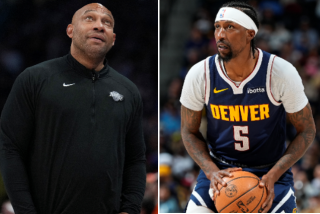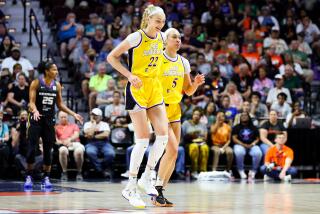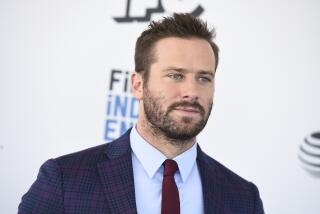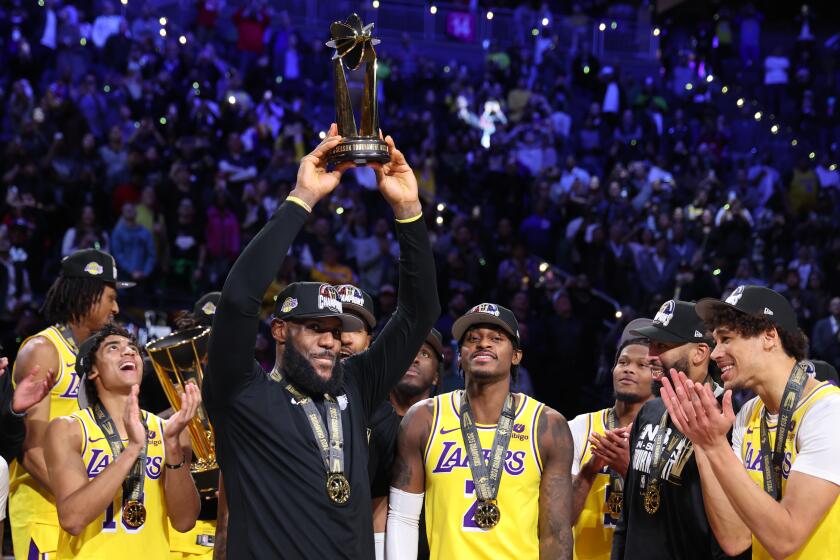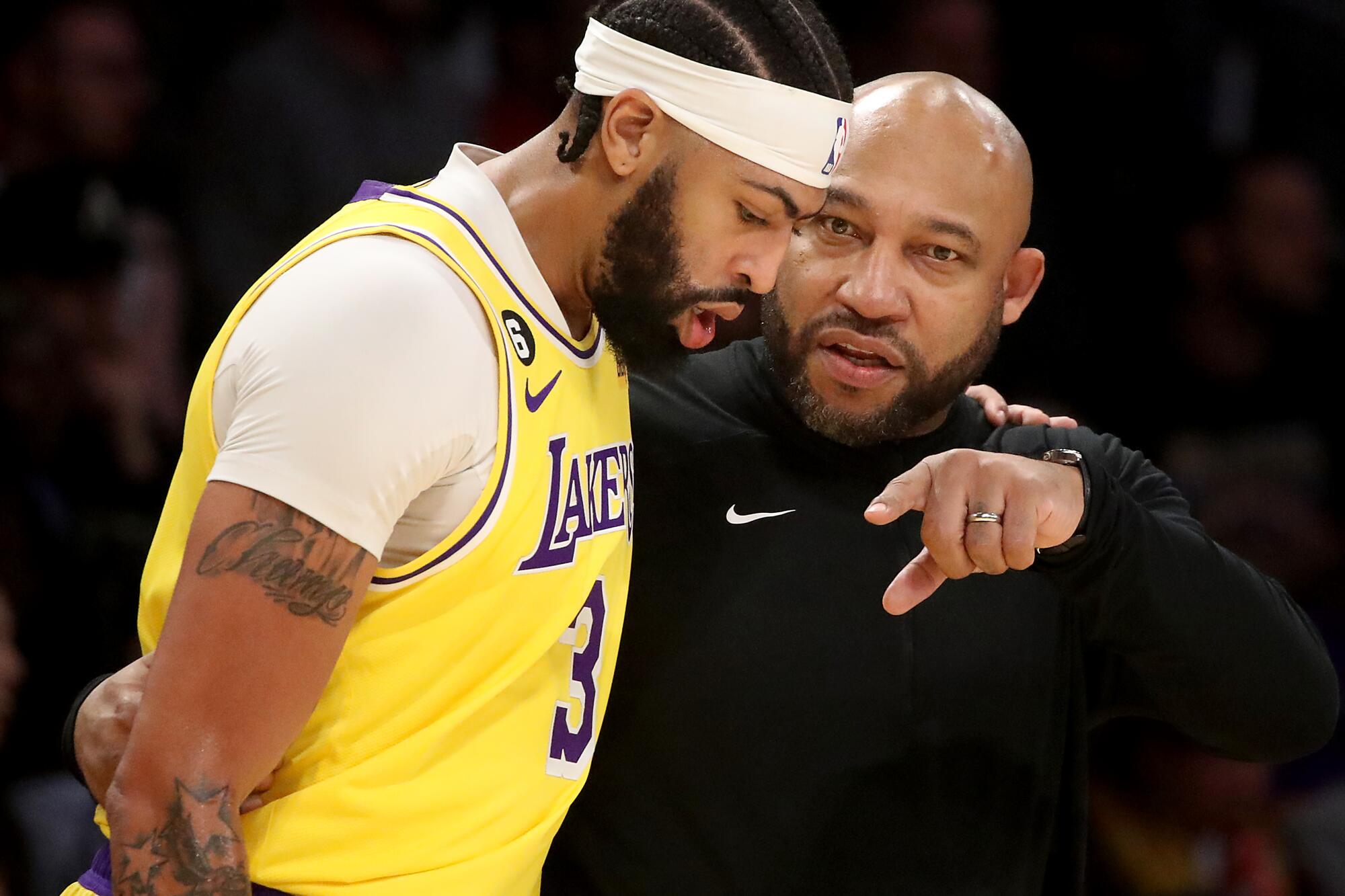
SAGINAW, Mich. — The bullet pierced the right side of Darvin Ham’s cheek, glanced off his jaw and lodged in the back of his neck.
It was April 5, 1988, a trip for pizza and soda with his older brother that went horribly wrong. A spray of bullets almost made Ham another casualty of his hometown.
Instead, it became a defining moment in the life of the man who would become the Los Angeles Lakers’ 28th head coach.
Blood was everywhere. Ham nearly died, needing 11 days in the hospital.
“Fourteen years old,” Ham, 49, said in an exclusive interview with The Times. “Think about it. I could’ve died. At 14.”
His voice quaked as he recounted the trauma, the first in an adolescence littered with them.
“’Walk it off,’ that’s what they’re telling me,” Ham said, his eyes tearing and reddening. “Walk it off. No, ‘How you feeling? Are you OK? Are you scared it could happen to you?’ … I got to give something back, man.”
It was far from the only trauma he suffered before he left town.
Too many friends buried, too many classmates lost to the crack cocaine epidemic, not enough support to process it all.
When the Lakers play in Detroit on Sunday, it’ll be the first time Ham returns to mid-Michigan as the Lakers’ first-year coach, one of American sports’ most prestigious and scrutinized jobs — coaching LeBron James, Anthony Davis and Russell Westbrook only 100 miles from the Saginaw streets that nearly swallowed him.
Now in the middle of a playoff run with the team, Ham’s helped stear the Lakers through internal controversy, a rebuilt roster, a months-long postseason push and, now, a series with the defending champion Warriors.
“It’s wild,” his childhood friend Eric Smith said. “… For someone from Saginaw to be the Lakers coach, that’s impossible. It can’t happen. But it did.”
“As Black people, we don’t have enough therapy. ... We think it’s cowardice or we’re weak if we go get help.”
— Darvin Ham on recovering from PTSD
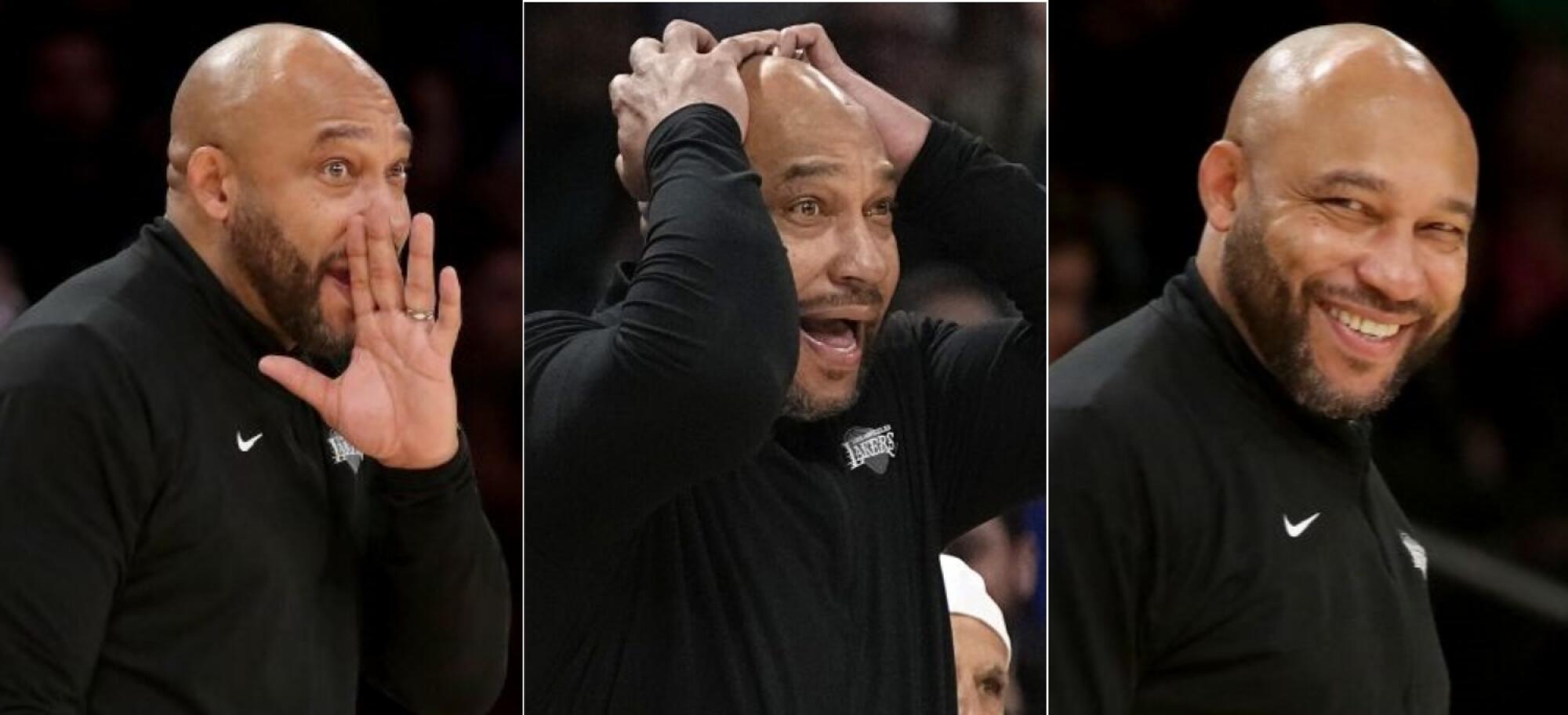
The weight of Ham’s past, even during a professional high point, is too heavy to hide yet too important to keep silent.
He must share.
“As Black people, we don’t have enough therapy,” Ham said. “I have PTSD [post-traumatic stress disorder] to this day off them shots ringing out, getting shot, the s--- going on in my neighborhood. And we don’t … we think it’s cowardice or we’re weak if we go get help.”
He paused for a moment.
“And we need so much help, bro.”
His work in therapy has helped him better understand the complex emotions Saginaw evokes in him, how it’s the setting for so much trouble and so much pain. It’s also where he was built, Eastside tough and ready to take on anything.
He met the pressure of a 2-10 start this season with patience and consistency, the Lakers recently ripping off seven wins in nine games, including one in Milwaukee.
“He has this incredible, I believe, balance where he’s kind of fierce, intimidating and has this presence. He’s ‘No bulls---,’ right?” Bucks general manager Jon Horst said. “But he also has the greatest smile, the greatest laugh, will put his arm around anybody. He’s like this inviting tough guy, this really crazy balance. And it’s consistent, his energy every day.
“He’s Darvin. He’s a tough motherf-----.”
Inside the diner with the clever name — the Bringer Inn — Marshall Thomas, 75, weaves through the tables. Before the legendary Saginaw High basketball coach could get to his grits, sausage patties and dry toast, he had to stop to talk to someone at every other table.
“When you coach,” Thomas said, “everyone in town knows you.”
A lifelong resident of Saginaw, Thomas has won a state championship. He coached NBA champion Draymond Green. And, in the fall before the 1991-92 season, Thomas trusted his returning players when they wanted to add Ham to the squad even though he hadn’t played a second of organized basketball at Saginaw High the previous three years.
Thomas has seen the lives ruined by Saginaw’s problems; he’s had his hands on changing plenty of them in town, too. It’s why he’s still here.
“I play the lotto, but I don’t want to hit it,” he says earnestly. “I don’t want to move from where I live. And if you hit the lotto big — not just for your sake but for your family’s sake — you probably have to move.
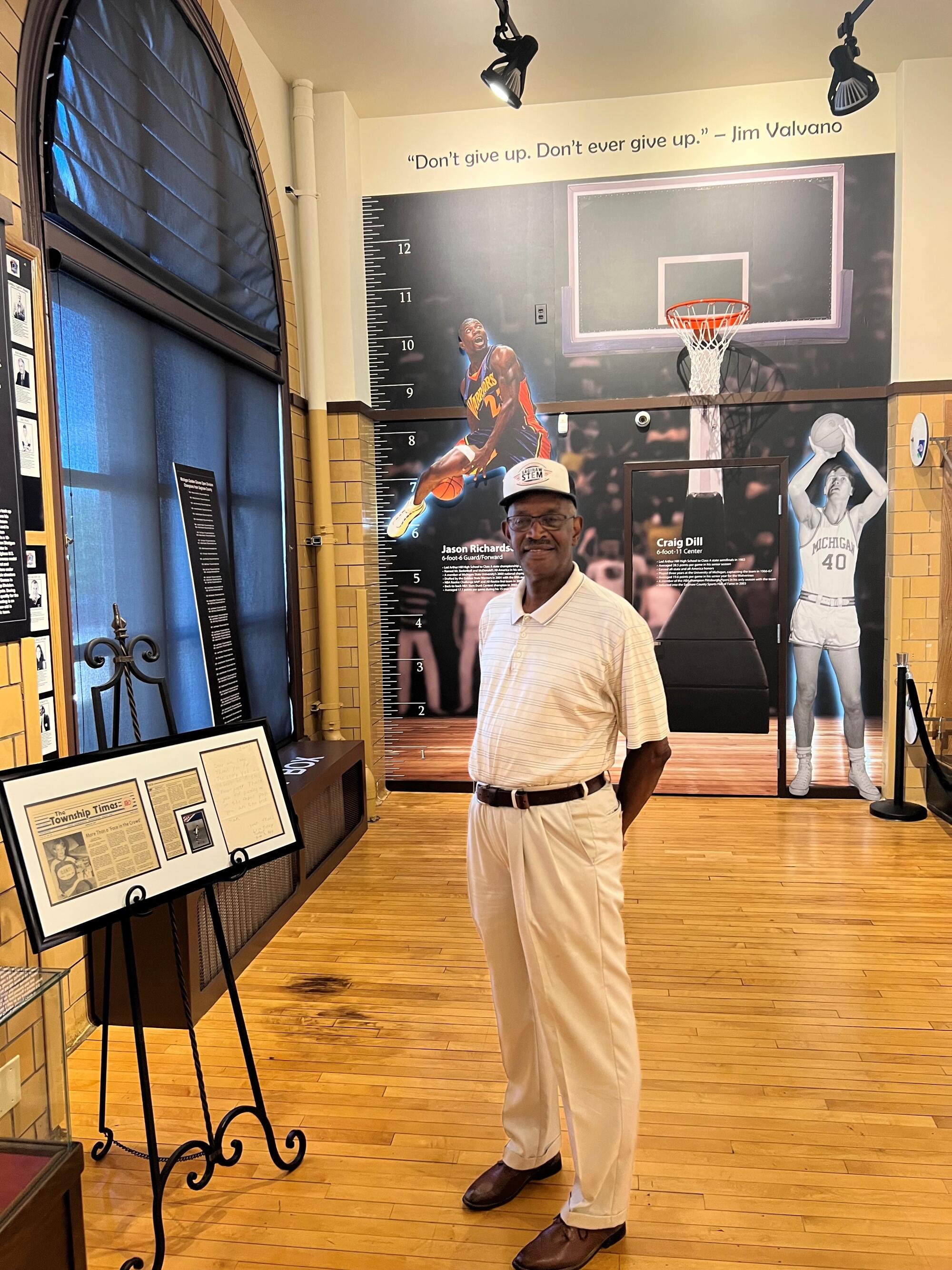
“But me, I like it.”
Despite surpassing Detroit as the most violent city in the state, Saginaw is also a city with a sprawling footprint that includes lush country clubs, massive cement mini-malls and manicured farmland, almost as if you took all the characteristics of the Midwest and compressed it into 18 square miles.
“Whatever you want, you can have in Saginaw,” said Julian Taylor, Ham’s teammate at Saginaw High. “You got the country part, the rural part. You got suburban parts. You got urban parts. Very diverse.”
No matter how bad it gets on your block, Taylor agreed, prosperity was just a short drive away. “Just across the bridge,” Ham said.
Too big to be called a town, too small to be considered a city, Saginaw’s early prosperity came from the lumber boom in the mid-19th century. When the source of wealth and work in the area quickly vanished, Saginaw became a manufacturing center similar to so many other Midwestern hubs with a tight tie to Detroit’s automobile industry.
“One fell swoop, I saw it go from being a tight-knit community, a neighborhood, and then the neighbors disappeared and now, it’s just a hood,” Ham said.
Quick money from drugs, especially crack, engulfed the areas around his home in violence.
“You saw things change, man,” Ham said. “I’m talking about kids coming to high school, thousand dollars in their pocket, big gold ropes, big-ass triple-fat goose coats, fur coats. It was real man, real.
“Thank God. I was around it, but I never got submerged in it if that makes sense.”
The lure, though, was real.
“Being in the midst, seeing things turn for the worst and kids I’m going to school with, going to church with, dibbling and dabbling in this life to the point where I dibbled and dabbled,” he said. “I jumped off the porch.”
Ham wanted to get away — too much violence and too much pain. He wanted to join the Air Force, like his father, Howard, but a late-night recruiting visit from a junior college coach desperate for a big man who could rebound put him on the path out of town.
While Saginaw forged the things that would turn Ham into a success — toughness, resourcefulness, adaptability and resolve — it also left him with scars he still can’t shake.
The scars? They weren’t from the bullet that ripped through his jaw. They were from the shotgun blast that killed Chaka Euell.
“Literally, I talked to him three hours before he was killed. … Man, he would be so proud of me right now.”
— Darvin Ham regarding his childhood friend Chaka Euell
Like Ham, Euell had to cheat death in Saginaw — both of the friends living through gunshot wounds to the face before they turned 18.
The pair grew up together, Ham calling Euell his “godbrother.”
Their families were connected through the Tabernacle Baptist Church. Ham and Euell would be in Sunday school one moment, rapping along to the latest LL Cool J or Run-DMC record the next.
“We just grew up like that, just tight,” Ham said. “And there came a time where he just went a little bit left.”
Drugs and gangs flourished as the city’s manufacturing epicenters began to crumble. The consequences were deadly.
Late on July 24, 1990, Euell and Benjamin Lee were beaten and shot to death where North 4th Avenue backs into Fitzhugh Street. It’s less than a mile from where Ham would one day be enshrined in the Saginaw County Sports Hall of Fame.
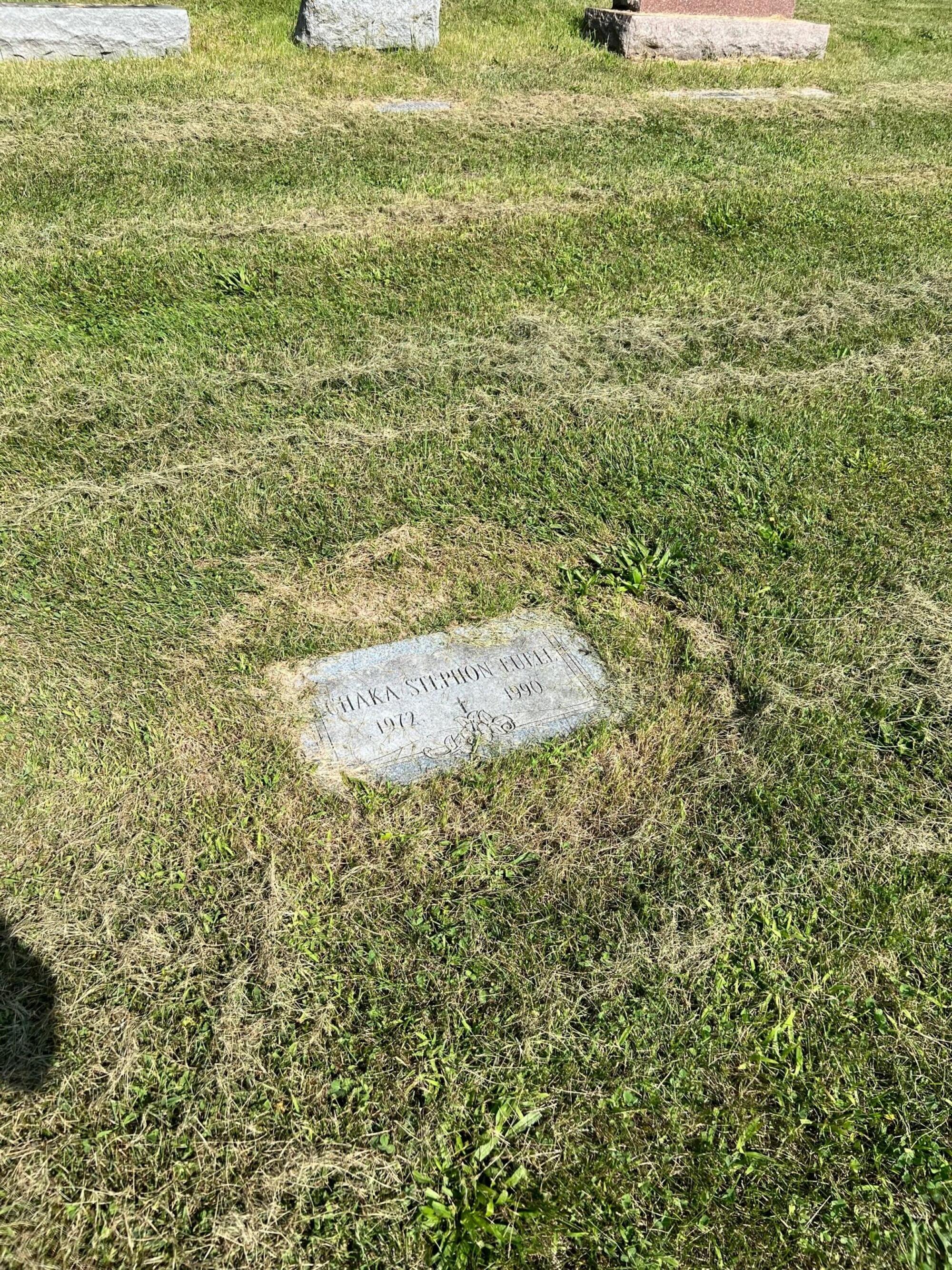
They were the 18th and 19th people killed that year. The killings equaled the totals from 1989 with four months left in the year, the city facing a gang and drug crisis that led the next day’s local newspaper.
“My brother, we separated. He went one way and I went the other,” Ham said as tears filled his eyes. “As we were trying to reconnect, he gets killed hours later. Literally, I talked to him three hours before he was killed.
“… Man, he would be so proud of me right now.”
Barely two years after he escaped his own death, Ham sat in the front of the church, with white gloves on his hands, ready to carry one of his best friend’s caskets to the back of a hearse and, eventually, into the Saginaw soil.
That day, Ham saw his father cry for the first time.
It was all part of a summer when Ham and his peers were drowning in loss. One friend, Elton Simmons, had been killed earlier in May. Another, Terrance Marsh, was killed less than a month after Euell.
The deaths — the senselessness of life being snuffed out amidst a gang war — started to test Ham. Later, he’d wonder why this all could happen — how could culture value Black people so much but society ignore their needs for help.
By the time Ham was 19, he’d have lost friends, a grandfather and his father — Howard dying in a car accident in 1992.
“I’ve lost a lot of people,” Ham said.
“Right then and there we should’ve known.”
— Julian Taylor on Darvin Ham’s ability to make the NBA when he dominated games and dunked so hard he cracked rims
In some ways, Ham was still searching for his place in the world as he entered his senior year of high school, the realities of street life everywhere. His low grade-point average kept him from trying out for football. But he’d sprouted to 6 feet 5 and the tight-knit guys on the Saginaw High basketball team thought he could help after they’d made a run to the state finals the previous year.
Ham, who worked hard to improve his grades, started playing with Taylor and the rest of the team, first meekly dunking on a side rim in the school gym. Soon, his ferocity started to translate to the main court.
Taylor and his teammates went to Thomas with a unanimous opinion. “We need Darvin on this team,” the players told their coach.
Ham made the varsity and contributed as a reserve, his defense and rebounding earning him minutes. He landed at Otero Junior College when the coach made a last-minute visit to Ham at home, a meeting facilitated by Thomas, who’d heard that Otero needed a big man.
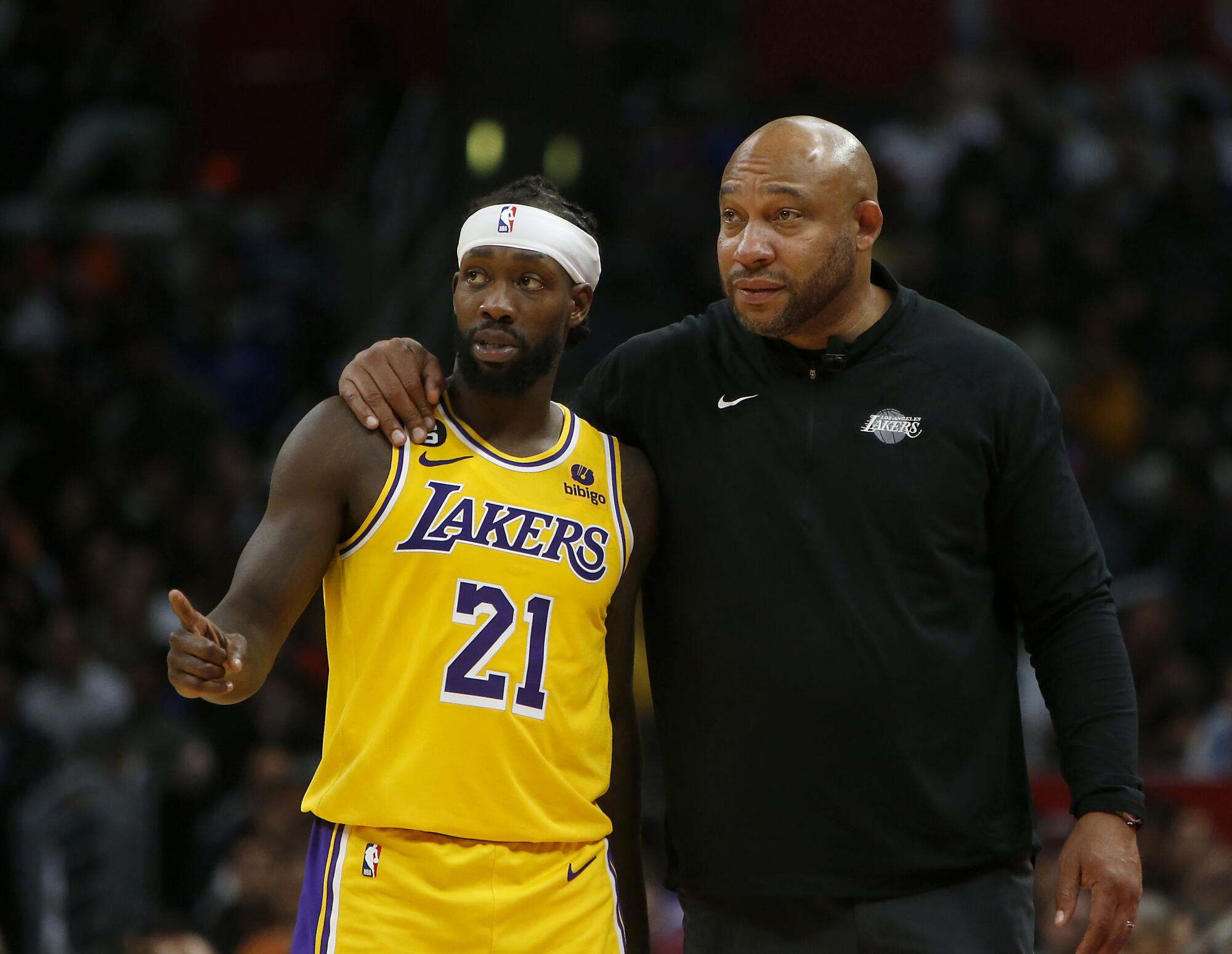
Ham’s first time home the following winter, he and the graduated players were getting ready to go back to Saginaw High to practice with the high school team.
“He called me and was like, ‘Whaddup?’ And I was like, ‘Who’s this?’ And it was Darvin. I was like, ‘Man, your voice got deeper!’” Taylor said laughing.
As Ham walked through the door to pick up his friend, his steps were loud and heavy. He needed to duck through the frame.
“I said, ‘Man, you done grew some more!’” Taylor said.
At that practice, Ham and Taylor ran through drills, including a full-court three-man weave. At the end of the drill, the ball went to Ham who dunked it so hard he cracked the rim.
“Right then and there,” Taylor said, “we should’ve known.”
But no one really did.
He played well enough in one season at Otero that Texas Tech offered him a scholarship.
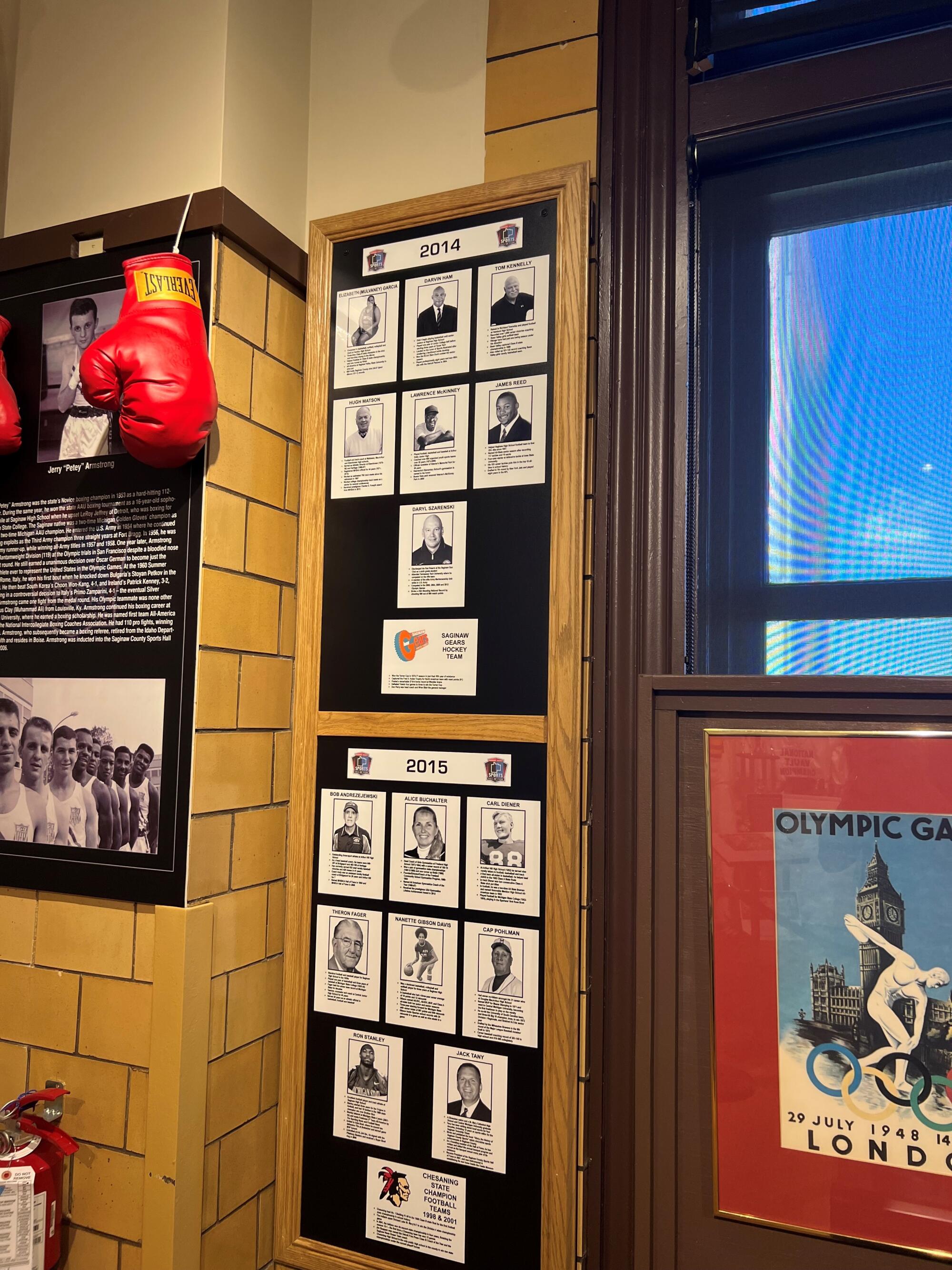
Before he went to Texas that fall, Ham returned to Saginaw, driving all over the city to play pick-up games with friends.
One of them, Santana Dottery, saw Ham dominate a three-on-three game despite having a broken right hand.
“I looked at him and I said, ‘Man, you’re going to the NBA,’” Dottery recalled. “I’d never seen someone do that.”
It was the first time anyone told Ham that the NBA was a possibility.
Dottery remembered Ham’s work ethic that summer, the future Lakers coach going everywhere with a weighted vest. He’d do one drill in which he’d jump and dunk over and over while wearing 50 pounds of weights around his chest.
“He was working out, breaking rims at the rec center, in summer leagues,” Dottery said. “That summer, he just went on a rampage.”
It took everyone else more time to figure out what Ham could become.
Though he was a valuable contributor on a Texas Tech team that would be ranked in the top 10 by his senior year, Ham hardly put up the numbers that screamed NBA career. As a senior, he averaged 9.1 points and 5.7 rebounds.
He made his name as a tough-nosed role player unafraid of dirty work and had grown to 6-7. To the rest of the sports world, he was the guy who shattered the backboard with a ferocious two-handed slam against North Carolina in the NCAA tournament. Sports Illustrated put Ham on its March 25, 1996, cover, a photo of him surrounded by shards of glass and the headline “Smashing!”
Those who knew Ham best knew this wasn’t just some feat of strength.
“People say, ‘You broke a backboard! What type of workouts were you doing?’” Well ...” Ham paused and laughed, “that was the PTSD, homie.”
“To really carve out a 10-year career and play on some good teams, I do think he’s an observer. Same as now, he’s a connector.”
— Mike Budenholzer, Bucks coach on Darvin Ham’s ability to communicate
His ascent from the Saginaw streets to the high school team to junior college to Texas Tech was rapid, aided by Ham’s willingness to do two of the things every coach values — defend and rebound.
Despite not being picked in the 1996 NBA draft, he joined the Denver Nuggets after a successful summer league tryout.
Ham called Dottery to give him the news.
“I didn’t believe in myself,” Dottery told Ham. “But I believed in you.”
Yet as he made it as a pro — Ham managed to play eight seasons in the league, plus stops in Spain, the Philippines and the NBA’s developmental league — he said the trauma he absorbed growing up continued to play out in ways that impacted his relationship with his wife, Deneitra.
On New Year’s Eve in 2001, Ham was arrested on Milwaukee’s eastside on suspicion of domestic violence. No charges were filed when Deneitra told police she wasn’t hurt in the incident, according to the Milwaukee Journal-Sentinel.
In 2005, Deneitra was sentenced to a year’s probation for hitting Darvin on the head with a wine bottle during a dispute in March of that year. Darvin was bleeding but refused medical treatment, according to the Associated Press.
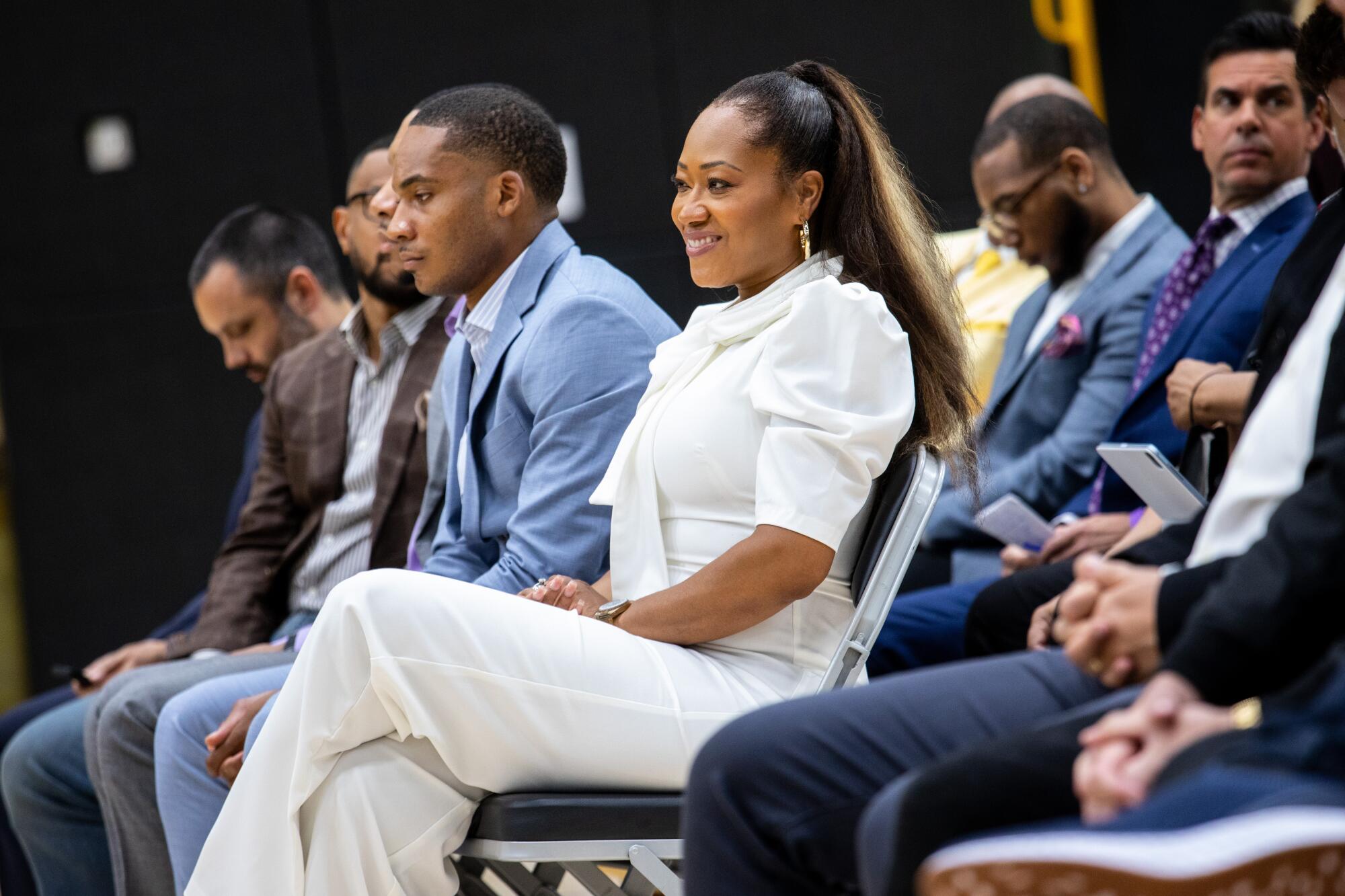
They are still together, Deneitra running their non-profit dedicated to pairing basketball players with life skills and mental wellness. Therapy has better helped Ham understand the kind of trauma he was dealing with and the continuous work required to reduce the impact on his family.
“My wife has bore the brunt of all of that … to the point where I’m not beating her or slapping her. I [was] actually beating her with my pain, mentally, emotionally — not physically,” Ham said of his PTSD. “It’s one of those things where one of the reasons she’s still by my side is because she sees that and gets on me about being better.”
Through those years of personal growth, Ham reached championship heights, winning a title with the 2004 Pistons, appearing in each of their wins in the 2004 NBA Finals against the Lakers.
“I think he’s an excellent leader,” said Chauncey Billups, the 2004 Finals MVP and current Portland Trail Blazers coach. “We won a championship together in Detroit. And he didn’t play that much but he was one of our leaders. His voice was really strong. Never over-used it. When he says something, you took heed to it. Always came from the right place, always about the team. It was never, like, personally for him.”
Ham is one of seven players in league history to play in at least 400 games and score fewer than 1,200 points — a testament to the overlooked things he did well and the roles within a team that he filled.
“Those jobs are hard to keep,” said Mike Budenholzer, the Milwaukee Bucks coach who hired Ham as an assistant in Atlanta and Milwaukee. “It’s where you turn [over the roster]. So many GMs and owners want someone young, or from the draft or a second-round pick. To really carve out a 10-year career and play on some good teams, I do think he’s an observer. Same as now, he’s a connector.
“You see a 10th guy who can connect everyone to the best player and you’re like, ‘Holy s---. His role is actually pretty important.’”
In his first official act as Lakers head coach, Ham sat underneath title banners with championship trophies framed by the biggest window inside their El Segundo training facility.
The walls display the names of the team’s legends — West, Baylor, Bryant, Johnson, Abdul-Jabbar, O’Neal. And here was Ham, the kid who escaped Saginaw, who played one year of high school basketball, getting his first chance to coach an NBA team — and that team being the Lakers.
“I was shot in the face by accident, April 5, 1988,” Ham said in his opening news conference. “You go through something like that, it’s going to be one of two things. It’s going to make you fearful or fearless. It made me fearless.
“I don’t feel pressure. It’s basketball.”
Ham immediately pushed back at the notion that he was some sort of rookie coach — he’d been working with Budenholzer for a decade and had stints in the NBa’s development league and on coach Mike Brown’s Lakers staff before that.
His contact list is stuffed with mentors willing to help, people such as Quin Snyder, Larry Brown, Budenholzer, Billups and Brown in his network. So many of Ham’s mentors worked for San Antonio coach Gregg Popovich that when the Lakers met the Spurs for the first time this season, Ham sought out Popovich to give him a hug.
“He’s one of those guys — he doesn’t need any character development, or pat on the ass or anything like that. He’s a ‘for real’ human being,” Popovich said of Ham. “And he understands, he came up the hard way. He wasn’t a star. The way he played garnered him respect from every other player and every other coach he was ever associated with. So he knows exactly what has to be done to win and lose, and he will be himself no matter what.
“Doesn’t matter who the top players are, 13th man on the squad, he’s gonna be Darvin Ham, and that’s a straightforward, tough dude who understands the game, and who will be fair, and enjoy developing relationships with those players. He’s good at it.”
The challenges with coaching the Lakers weren’t lost on Ham’s colleagues around the NBA. Many privately worried about the star dynamics, the fit of the roster and the limitations to rapidly improving it. There was the issue of Westbrook, coming off his worst season in the NBA.
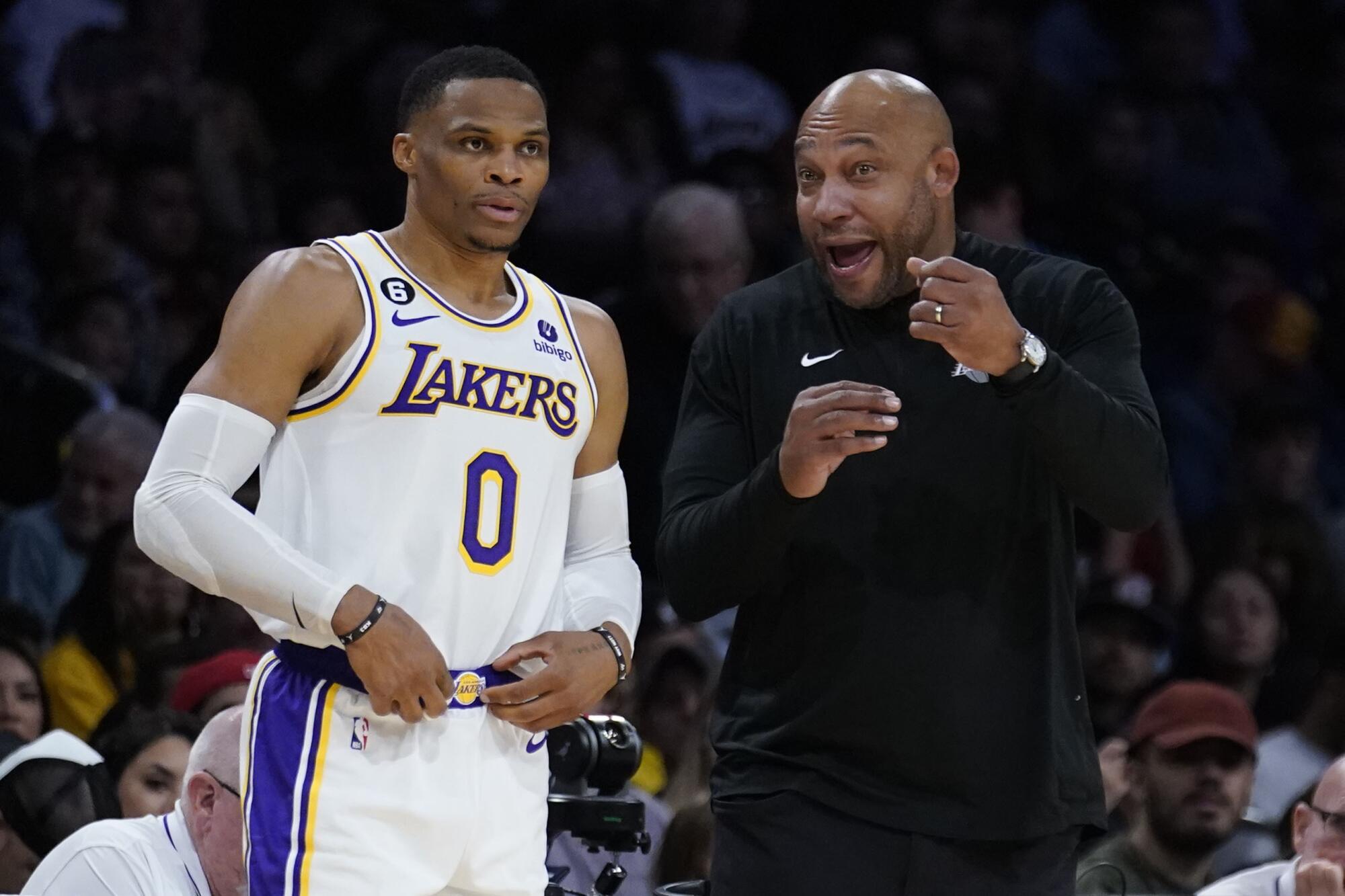
Yet for someone like Budenholzer, who saw Ham’s biggest strengths at work, he saw his former assistant as the right guy for the job.
“Darvin as an assistant coach has been having really hard, almost head-coach-like, conversations and isn’t afraid,” Budenholzer said. “It’s a challenging job. And at the end of the day, you’ve got to challenge guys. And you have to tell them things they maybe don’t want to hear and find a way to wrap that up or maybe make them feel better about it. It’s important. And just particularly compared to me, and probably a lot of guys — he does it in life — he has real conversations on the regular.
“He’s built for those hard conversations. And that’s why he was invaluable for me.”
As the Bucks considered whether to play during the NBA bubble in the wake of the Jacob Blake shooting in Kenosha, Wis., people inside the team say Ham was one of the most powerful voices, tears flowing as he shared his perspective with the players.
The Bucks’ decision not to play that day triggered a movement across all sports to bring more attention to racial inequality and police violence.
Within the context of the Lakers, Ham has already had to deal with significant issues. He and Westbrook navigated most of the trappings that come with moving a former MVP to the second unit. Despite two five-game losing streaks in the Lakers’ first 12 games, the team has shown significant signs of improvement to claw back into the Western Conference playoff mix.
The Lakers still have a long way to go to live up to the standards set by the franchise, the path to a record-setting 18th championship still murky at best. But there’s no fear of the process.
“I’m not scared. I’m not afraid. All this,” Ham said as he pointed to the Lakers’ championship banners and trophies, “I’ve done that twice before. I appreciate being in the presence of greatness — but I’m great too.”
He’s not being cocky. Ham instead is talking about life, about being a Black man who has achieved against odds, who managed to find a way for himself even though he took a bullet in his neck before he could get a driver’s license.
Though he’s still carrying heavy emotions about all that happened in Saginaw, he’s proud of what it helped make him and all it prepared him for.
“I’m not overwhelmed by this,” Ham said. “I got taught about being here versus not being here early. When I say, ‘being here’ I mean ‘alive.’ When people say, ‘Man, this is the Lakers’ or ‘there’s pressure,’ bro, this is light work.
“Light work, bro. Light.”
More to Read
All things Lakers, all the time.
Get all the Lakers news you need in Dan Woike's weekly newsletter.
You may occasionally receive promotional content from the Los Angeles Times.

